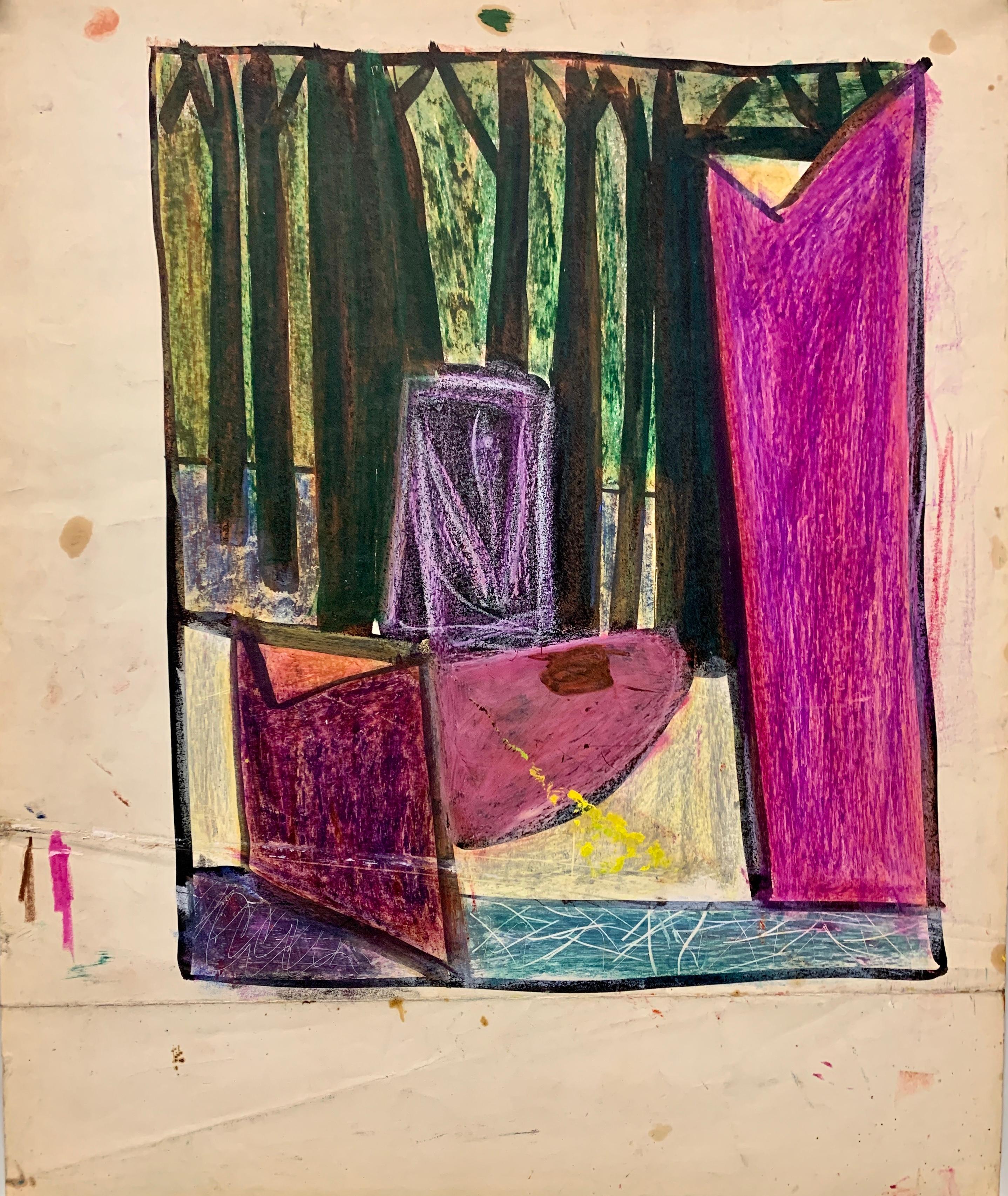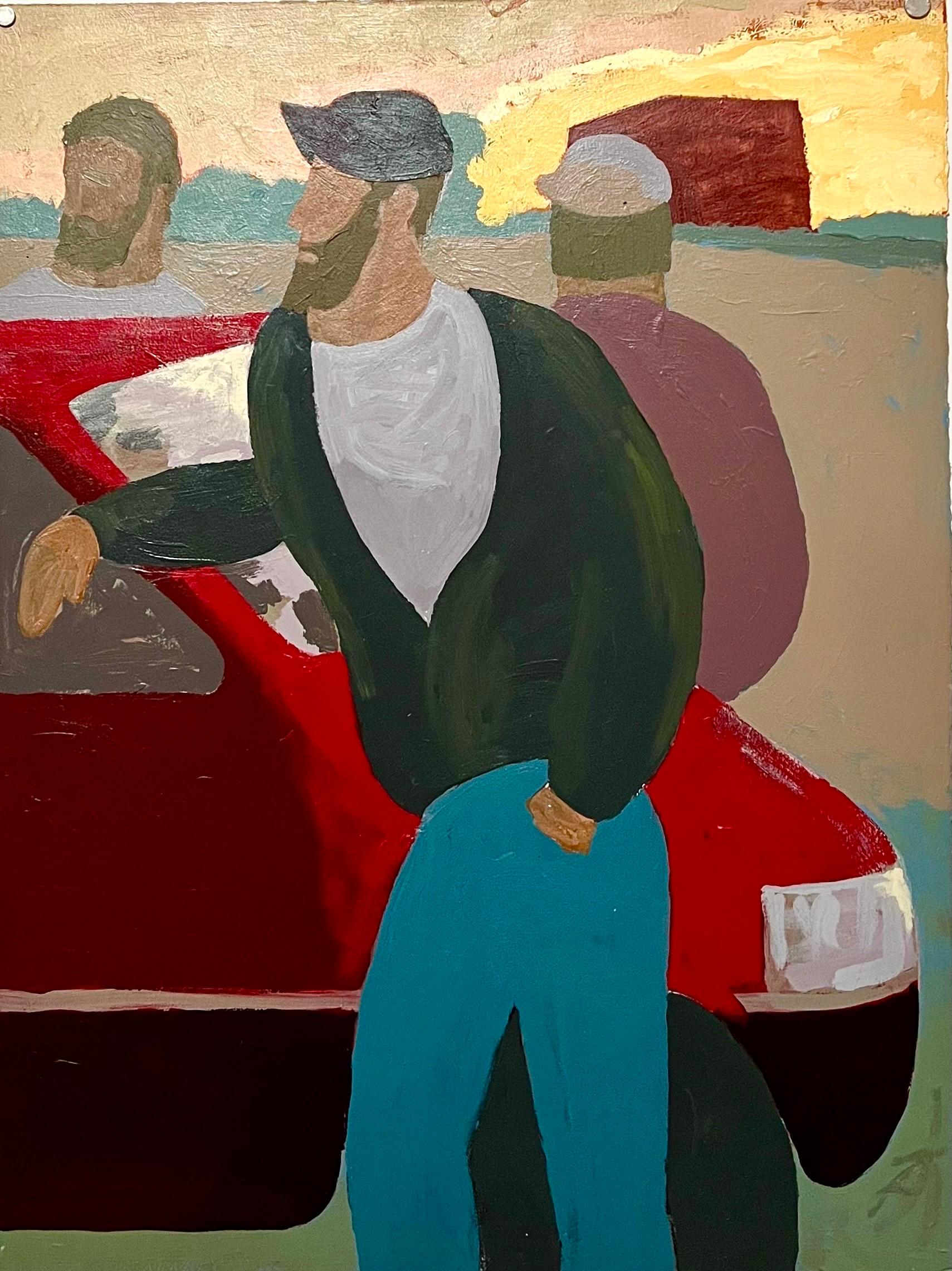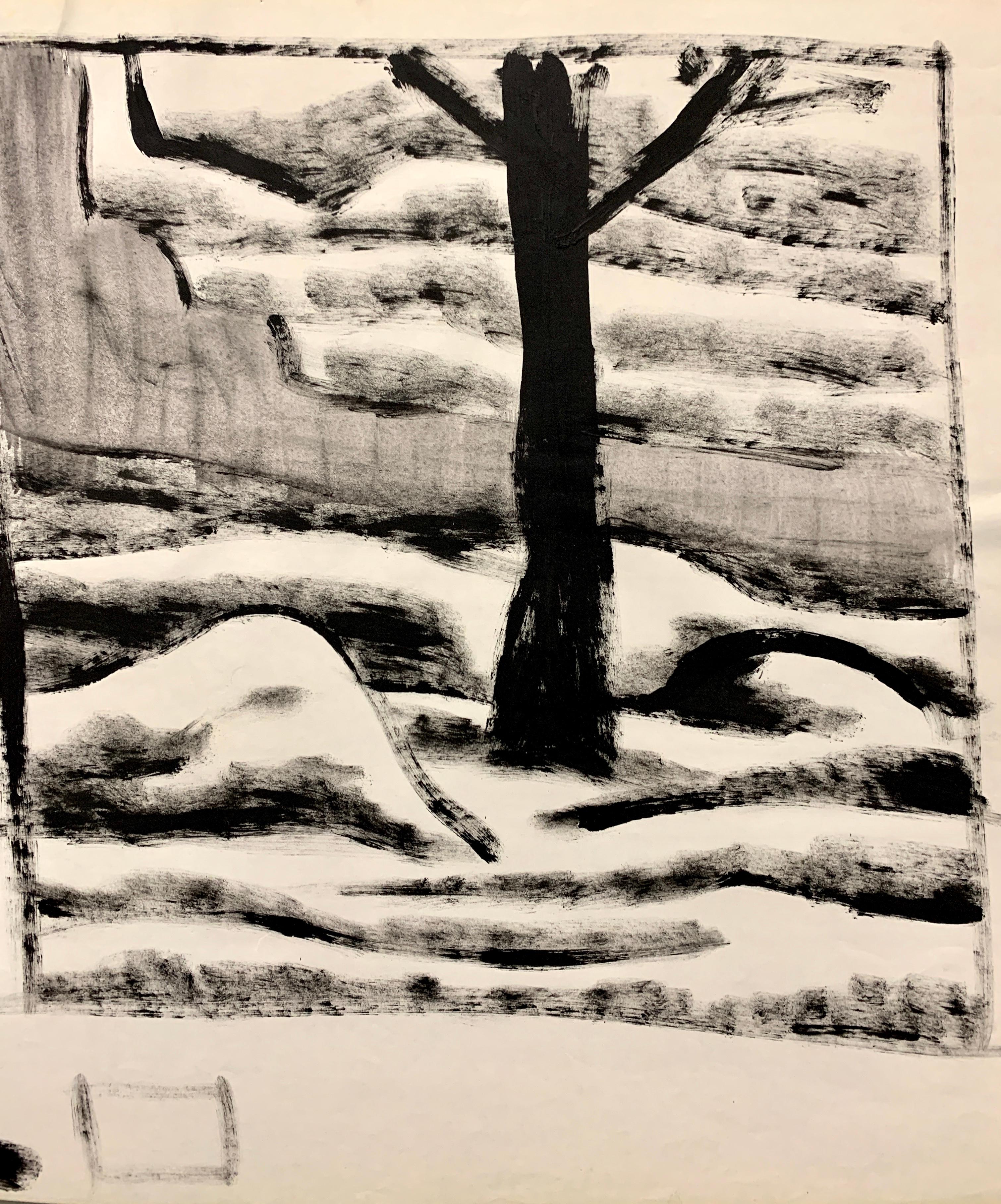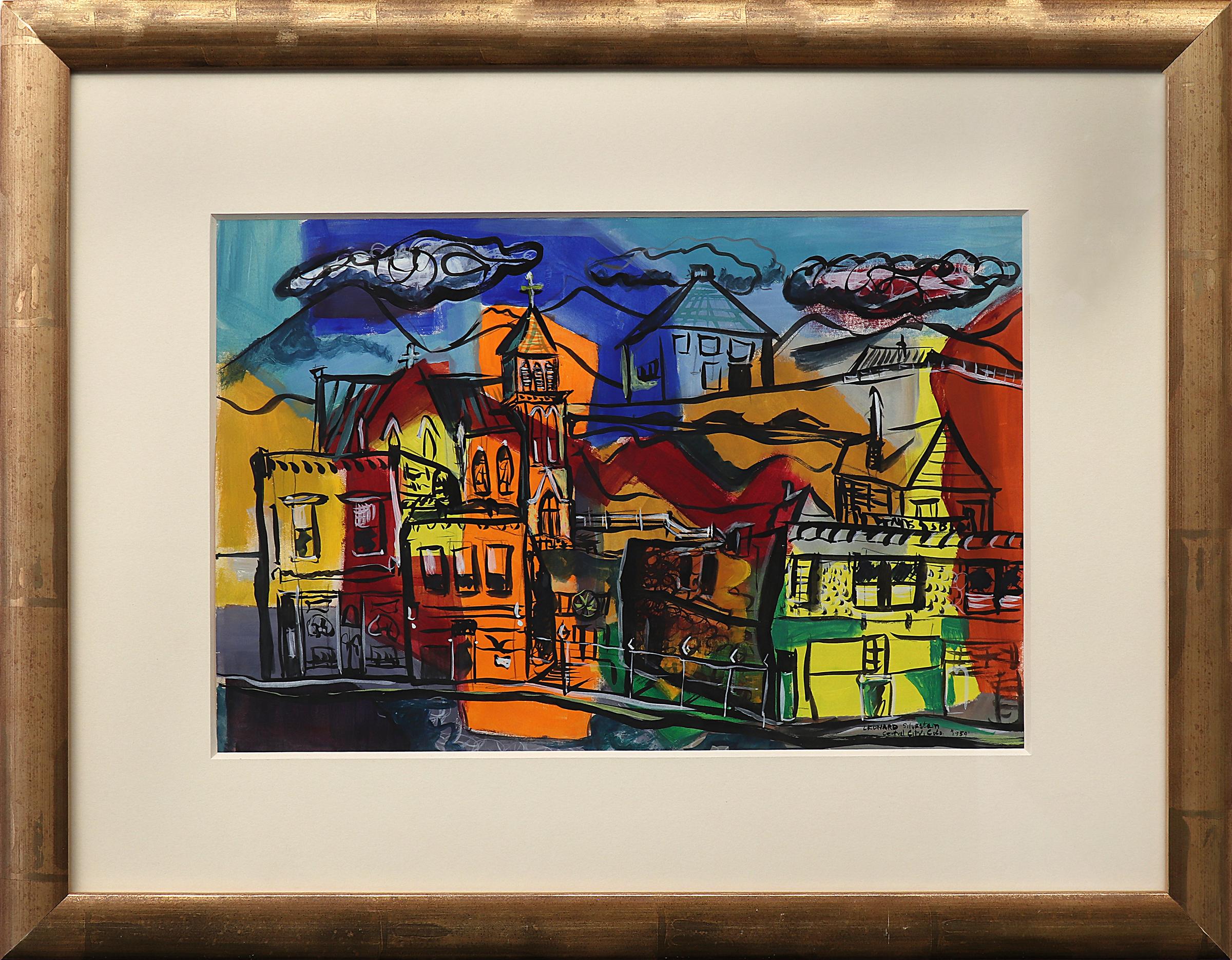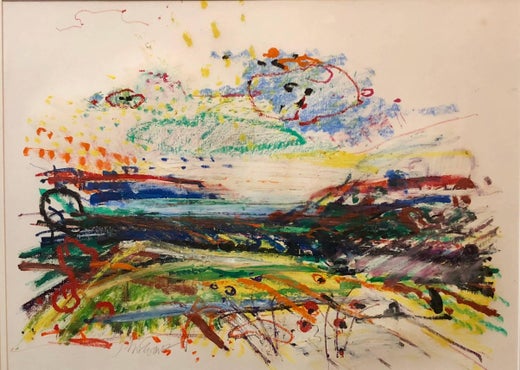Items Similar to Untitled Abstract Landscape Oil Pastel Painting Figurative Abstraction
Want more images or videos?
Request additional images or videos from the seller
1 of 12
John EvansUntitled Abstract Landscape Oil Pastel Painting Figurative Abstraction1995
1995
About the Item
John Evans (American, b. 1945), Untitled oilstick on paper, signed in pencil lower center, gallery label (Allan Stone Gallery, New York) affixed verso, sheet: sight size is 22"h x 30"w, overall (with frame, frame needs replacing): 32"h x 39.5"w (the number on the stickers verso is different. not sure why)
John Evans earned his MFA in 1979 from Boston University, where he studied under Abstract Expressionist painter Philip Guston and James Weeks, who was part of the movement of Bay Area Figurative School painters (which inluded artists such as Richard Diebenkorn.) He has exhibited at museums and galleries across the U.S., and received reviews in publications including Art in America, The Wall Street Journal, and Art News. He is found in the collections of the National Museum of American Art, Washington, D.C.; the Museum of Fine Arts, Boston; and the Fogg Art Museum at Harvard University, among others.
SELECT GROUP EXHIBITIONS
2010 Cadogan Contemporary, London, UK
2006 "40 Years: A Dealer's Collection," Gallery Henoch, New York, NY
2001 Lowe Gallery, Atlanta, GA - New Works Summer Show
2000 Hackett Freedman Gallery, San Francisco, CA - "Four Artists- Robert DiNiro Sr., Paul Resika, John Evans, Dennis Hare"
1997 National Museum of American Art, Smithsonian Institute, Washington,DC - Singular Impressions: The Monotype in America
1997 Allan Stone Gallery, ADAA, New York, NY - "The Art Show"
1994 Newton Art Center, Newton, MA - Nine Artists Who Studied With Philip Guston
1994 International Art Exposition, Miami, FL - Art Miami
1992 Gay Head Gallery, Martha's Vineyard, MA
1990 Capital Cities / ABC,NY,NY - "37 Painters and Sculptors: On View"
SELECTED COLLECTIONS
Smithsonian American Art Museum, Washington, DC
Museum of Fine Arts, Boston, MA
Fogg Art Museum, Cambridge, MA
Houston Museum of Fine Arts, Houston, TX
Decordova Museum, Lincoln, MA
Rose Museum, Brandeis University, Waltham, MA
Arkansas Art Center, Little Rock, AK
Boston Public Library, Boston, MA
AT&T, New York, NY
Chase Manhatten Bank, New York, NY
E.F. Hutton & Co., New York, NY
BankBoston, Boston, MA
- Creator:John Evans (1945, American)
- Creation Year:1995
- Dimensions:Height: 32 in (81.28 cm)Width: 39.5 in (100.33 cm)
- Medium:
- Movement & Style:
- Period:
- Condition:needs new frame.
- Gallery Location:Surfside, FL
- Reference Number:1stDibs: LU38212582332
John Evans
John Evans (b. 1945, Mt. Vernon, NY) earned his BFA and MFA at Boston University. Having settled in Massachusetts, Evans was early inspired by his surroundings, creating loosely abstracted landscapes depicting boats and sunsets. His attraction to nature is more recently revealed in free-form paintings of water lilies and other plant life. Evans is drawn to bright colors and applies them liberally to his paintings, seeking to create drama among forms that are both planned and impromptu: “I want to make it happen gesturally and spontaneously, build a coherence, build a richness, build a complexity, so it doesn’t go away after a glance... So it’s something that you can spend some time reading and savoring. Making something out of nothing, giving form to expression, is a very powerful, satisfying drive. That’s what brings me out to paint every day.” Evans has been the focus of numerous solo exhibitions. His work is placed in important public and private collections, including the Smithsonian Art Museum; the Museum of Fine Arts, Boston; the Museum of Fine Arts, Houston; and the Fogg Art Museum, Cambridge. Over the years, his paintings have been featured in ARTnews, Art in America, and the Boston Globe, among others.
About the Seller
4.9
Platinum Seller
These expertly vetted sellers are 1stDibs' most experienced sellers and are rated highest by our customers.
Established in 1995
1stDibs seller since 2014
1,559 sales on 1stDibs
Typical response time: 1 hour
- ShippingRetrieving quote...Ships From: Surfside, FL
- Return PolicyA return for this item may be initiated within 3 days of delivery.
More From This SellerView All
- Large Hudson River Figurative Modernist Landscape Oil Painting Edward AvedisianBy Edward AvedisianLocated in Surfside, FLEdward Avedisian ( 1936-2007 ) Gouache or oil on paper, 3 guys around a car, hand signed in paint lower left, Measures 30"x 22.5" Edward Avedisian (June 15, 1936, Lowell, Massachusetts – August 17, 2007, Philmont, New York) was an American abstract painter who came into prominence during the 1960s. His work was initially associated with Color field painting and in the late 1960s with Lyrical Abstraction and Abstract Expressionism. He studied art at the School of the Museum of Fine Arts, Boston. By the late 1950s he moved to New York City. Between 1958 and 1963 Avedisian had six solo shows in New York. In 1958 he initially showed at the Hansa Gallery, then he had three shows at the Tibor de Nagy Gallery and in 1962 and 1963 at the Robert Elkon Gallery. He continued to show at the Robert Elkon Gallery almost every year until 1975. During the 1960s his work was broadly visible in the contemporary art world. He joined the dynamic art scene in Greenwich Village, frequenting the Cedar Tavern on Tenth Street, associating with the critic Clement Greenberg, and joining a new generation of abstract artists, such as Darby Bannard, Kenneth Noland, Jules Olitski, and Larry Poons. Avedisian was among the leading figures to emerge in the New York art world during the 1960s. An artist who mixed the hot colors of Pop Art with the cool, more analytical qualities of Color Field painting, he was instrumental in the exploration of new abstract methods to examine the primacy of optical experience. One of his paintings was appeared on the cover of Artforum, in 1969, his work was included in the 1965 Op Art The Responsive Eye exhibition at the Museum of Modern Art and in four annuals at the Whitney Museum of American Art. His paintings were widely sought after by collectors and acquired by major museums in New York and elsewhere. He has been exhibited in prominent galleries, such as the Anita Shapolsky Gallery and the Berry Campbell Gallery in New York City. Edward Avedisian was known for his brightly colored, boldly composed canvases that combined Minimalism's rigor, Pop art exuberance and the saturated tones of Color Field painting. Roberta Smith of the NYT writes of Avedesian: "Edward Avedisian helped establish the hotly colored, but emotionally cool, abstract painting that succeeded Abstract Expressionism in the early 1960s. This young luminary harnessed elements of minimalism, pop, and color field painting to create prominent works of epic proportions that energized the New York art scene of the time." In 1996 Avedisian showed his paintings from the 1960s at the Mitchell Algus Gallery, then in SoHo. His last show, dominated by recent landscapes, was in 2003 at the Algus gallery, now in Chelsea. Selected Exhibitions: Op Art: The Responsive Eye, at the Museum of Modern Art, Whitney Museum’s Young America 1965 Expo 67, held in Montreal, Canada. Six Painters (along with Darby Bannard, Dan Christensen, Ron Davis...Category
20th Century American Modern Landscape Paintings
MaterialsOil, Gouache, Archival Paper
- Modernist Abstract Expressionist Watercolor Painting Bauhaus Weimar Pawel KontnyBy Pawel KontnyLocated in Surfside, FLAbstract watercolor composition bearing the influence of the earlier color-block compositions of Paul Klee. Pawel August Kontny, (Polish-German-American artist) He was born in Laurahuette, Poland, in 1923, the son of a wealthy pastry shop owner. In 1939 he began studying architecture in Breslau where he was introduced to the European masters and to the work of some of the German Expressionists, soon afterward banned as "degenerate artists" and removed from museums throughout Germany by the Nazi regime. His studies were interrupted by World War II. Drafted into the German army, traveling in many countries as a soldier, he sketched various landscapes but in 1945, he was captured and held as a prisoner of war in Italy. After the war, he studied at the Union of Nuremberg Architects to help design buildings to replace ones destroyed in the war. He recorded his impressions of the local population and the landscapes through his watercolors and drawings. Pawel Kontny thereafter moved to Nuremberg, Germany, becoming a member of the Union of Nuremberg Architects and helping to rebuild the city's historic center. He soon decided to concentrate on his professional art career. He married Irmgard Laurer, a dancer with the Nuremberg Opera. Pavel Kontny 's career as an artist was launched with his participation in an all German exhibition, held at the Dusseldorf Museum in 1952. He held one-man shows in Germany, Switzerland and the United States. During his trip to the United States in 1960, Kontny became instantly enamored with Colorado, and decided to relocate to Cherry Hills with his wife and two children. He quickly established himself in the local art community, being affiliated for a time with Denver Art Galleries and Saks Galleries. His subject matter became the Southwest. During this time he received the Prestigious Gold Medal of the Art Academy of Rome. His extensive travel provided material for the paintings he did using his hallmark marble dust technique. he also worked equally in pastel, watercolor, charcoal and pencil-and-ink. in a style which merged abstraction and realist styles, influenced by Abstract Expressionist painting and South Western American landscapes. In the early 1960s he was one of only a few European-born professional artists in the state, a select group that included Herbert Bayer (1900-1985), a member of the prewar Bauhaus in Weimar and Dessau, Germany, and Roland Detre (1903-2001), a Hungarian modernist painter. As a Denver, Colorado resident, Pavel Kontny exhibited at galleries and museums throughout the United States, Germany and Japan. There, he was inspired by frequent trips to Native American pueblos in the Southwest, as well as by the study of the Plains Indians of Montana and Wyoming. Over the years Kontny had a number of students and generously helped young artist by hosting exhibitions at his Cherry Hills home. For many years he generously donated his paintings to support charitable causes in Denver. Influences during his European years included German pastelist C.O. Muller, German Informel painter Karl Dahmen and Swiss artist, Hans Erni. In the early 1950s his painting style showed the influence of the Die Brücke (The Bridge), a group of German expressionist artists formed in Dresden in 1905 who had a major impact on the evolution of modern art in the twentieth century in Germany. By the middle of the decade his style incorporated more referential abstraction and total abstraction, resulting in part from his study of Hans Hartung, a German artist based in Paris who exhibited his gestural abstract work in Germany. The American moon landing in 1969 inspired Paul Kontny...Category
20th Century American Modern Landscape Paintings
MaterialsCanvas, Oil
- American Woman Artist Modernist Large Oil Painting Cubist Influenced LandscapeBy Lena GurrLocated in Surfside, FLA beautiful wooded landscape scene with houses and trees. Painted on a masonite board. hand signed lower right. with framers label verso. Framed to 40 X 55 inches. 33 X 48 without the frame and mat. It is not dated. Lena Gurr (1897–1992), was an American woman artist who made paintings, prints, and drawings During the course of her career Gurr's compositions retained emotional content as they evolved from a naturalistic to a semi-abstract cubist style. Born into a Russian-Jewish Yiddish speaking immigrant family, she was the wife of Joseph Biel, also Russian-Jewish and an artist of similar genre and sensibility. Gurr used Lena Gurr as her professional name. After marrying Joseph Biel she was sometimes referred to as Lena Gurr Biel. Biel had been born in Grodno, Poland (later absorbed into Russia) and had lived in England, France, and Australia before coming to New York. An artist, he specialized in landscape paintings and silkscreen printing as well as photography. He studied art at the Russian Academy in Paris. After immigrating to the United States, he studied under George Grosz at the Arts Students League. Gurr was born in Brooklyn and, apart from brief stays in Manhattan and in Paris, lived there her whole life. This painting bears the influence of Lyonel Feininger an influential German American artist. Gurr began studying art at a young age. In 1919 she studied painting and printmaking at the Educational Alliance Art School and between 1920 and 1922 she won a scholarship to attend the Art Students League where she took classes with John Sloan and Maurice Sterne. In 1926 and 1928 Gurr participated in group shows at the Whitney Studio Club in Greenwich Village and in 1928 she also participated in the 12th annual exhibition of the Society of Independent Artists at the Waldorf Roof in New York. (Reviewing this show, Helen Appleton Read, the critic for the Brooklyn Daily Eagle, said "I made three discoveries on my first visit, Thomas Nagel, Eugenie McEvoy and Lena Gurr with two figure compositions which have something of Marie Laurencin or Helene Perdriat quality of naive sophistication.") The Waldorf Roof was a set of rooms on the top floor of the Waldorf Astoria Hotel, one of which had glass sides and a glass roof. The rooms were used for concerts, dances, benefits, and exhibitions.From 1929 to 1931 Gurr took a leave of absence from her teaching position to travel in France with Joseph Biel, an artist whom she had met while studying at the Art Students League. They spent time in Nice and Mentone but mainly in Paris. During the early months of 1931, while she was still abroad, her work appeared in group exhibitions held at the R. H. Macy department store and the Opportunity Gallery (opened by Gifford Beal). In 1932 she participated in three shows: a solo exhibition at the Brooklyn Museum, an annual exhibition of the New York Society of Women Artists, ( Its first president was Marguerite Zorach. Founding members included Agnes Weinrich, Anne Goldthwaite...Category
Mid-20th Century American Modern Landscape Paintings
MaterialsOil, Panel
- Modernist Colorado Oil Painting Abstract Cityscape Harbor Scene Pawel KontnyBy Pawel KontnyLocated in Surfside, FLUrban landscape of city harbor, marine scene, (North Africa?) bearing the influence of the earlier color-block compositions of Paul Klee. Modernist Cityscape 24" x 36" sight. oil on ...Category
20th Century American Modern Landscape Paintings
MaterialsCanvas, Oil
- Large Richard Merkin Painting Harlem Jazz Club, New Yorker Magazine Cover ArtistBy Richard MerkinLocated in Surfside, FLRichard Marshall Merkin (American, 1938-2009) Gladys and Half-Pint Hand signed 'Merkin' (center right), Titled, inscribed, dated, and initialed 'GLADYS BENTLEY AND FRANKIE 'HALF-PINT' JAXON 1997/R.M.' verso. Oil on canvas 37 1/2 x 72 in. (95.3 x 182.9 cm) framed 39 1/4 x 74 x 2 in. Gladys Alberta Bentley (August 12, 1907 – January 18, 1960) was an American blues singer, pianist, and entertainer during the Harlem Renaissance. Her career skyrocketed when she appeared at Harry Hansberry's Clam House, a well-known gay speakeasy in New York in the 1920s, as a black, lesbian, cross-dressing performer. She headlined in the early 1930s at Harlem's Ubangi Club, where she was backed up by a chorus line of drag queens. She dressed in men's clothes (including a signature tailcoat and top hat), played piano, and sang her own raunchy lyrics to popular tunes of the day in a deep, growling voice while flirting with women in the audience. On the decline of the Harlem speakeasies with the repeal of Prohibition, she relocated to southern California, where she was billed as "America's Greatest Sepia Piano Player" and the "Brown Bomber of Sophisticated Songs". She was frequently harassed for wearing men's clothing. She tried to continue her musical career but did not achieve as much success as she had had in the past. Bentley was openly lesbian early in her career, but during the McCarthy Era she started wearing dresses and married, claiming to have been "cured" by taking female hormones. Frankie "Half-Pint" Jaxon, born Frank Devera Jackson was an African American vaudeville singer, stage designer and comedian, popular in the 1920s and 1930s. He was born in Montgomery, Alabama, orphaned, and raised in Kansas City, Missouri. His nickname of "Half Pint" referred to his 5'2" height. He started in show business around 1910 as a singer in Kansas City, before travelling extensively with medicine shows in Texas, and then touring the eastern seaboard. His feminine voice and outrageous manner, often as a female impersonator, established him as a crowd favorite. By 1917 he had begun working regularly in Atlantic City, New Jersey and in Chicago, often with such performers as Bessie Smith and Ethel Waters, whose staging he helped design. He served slightly less than a year in the United States Army in 1918–1919 and rose to the rank of sergeant. In the late 1920s he sang with top jazz bands when they passed through Chicago, working with Bennie Moten, King Oliver, Freddie Keppard and others. He performed and recorded with the pianists Cow Cow Davenport, Tampa Red and "Georgia Tom" Dorsey, recording with the latter pair under the name of The Black Hillbillies. He also recorded with the Harlem Hamfats. In the 1930s, he was often on radio in the Chicago area, and led his own band, titled Frankie "Half Pint" Jaxon and His Quarts of Joy. Jaxon appeared with Duke Ellington in a film short titled Black and Tan (1929), and with Bessie Smith in "St. Louis Blues" (1929). Cab Calloway's "Minnie the Moocher" (1931) is based both musically and lyrically on Jaxon's "Willie the Weeper" (1927). Richard Merkin, Sometimes described as Rhode Island’s most famous New York artist, Richard Merkin has led a dual life for nearly 40 years - teaching at RISD while enjoying a celebrated painting career based in New York City. He has exhibited in countless gallery and museum shows in the US and abroad and is represented in the permanent collections of the Smithsonian Institution, The Museum of Modern Art, the Whitney Museum, the RISD museum and many others. In addition to contributing drawings and paintings to The New Yorker (along with, Art Spiegelman, Saul Steinberg, Harper’s, The New York Times Sunday Magazine and several books on Erotica and Baseball, he is a contributing editor for Vanity Fair and a former style columnist for GQ. Merkin’s honors include a Tiffany Foundation Fellowship and the Rosenthal Foundation Award from the American Academy of Arts and Letters. Museums and Selected Collections : The American Federation of Arts, New York, NY Brooklyn Museum, Brooklyn, NY Chrysler Museum of Art, Norfolk, VA First city Bank, Chicago, Ill Fisk University Art Gallery, Nashville, TN Hallmark Collections, Kansas City, MO Massachusetts Institute of Technology, Cambridge, MA Maimi-Dade Junior College, Miami, FL Michigan State University, East Lansing, MI Minnesota Museum of Art, Minneapolis, MN Museum of Modern Art, New York, NY Museum of Art, Rhode Island School of Design, RI McClung Museum, University of Tennessee, Knoxville, TN Pennsylvania Acadamy of the Arts, Philadelphia PA Prudential Insurance Company, Boston, Ma Prudential Insurance Company, Newark, NJ Rose Art Museum, Brandeis University, Waltham, MA Sara Robey Foundation, New York, NY Smithsonian Institution, Washington, DC State University of Brockport, Brockport, NY Whitney Museum of American Art, New York, NY Selected Publications : 1986-Present Contributing Editor, Vanity Fair ..1988-Present, New Yorker... 1988-Present, style column, GQ...1997, Text and Illustration for The Tijuana Bibles, published by Simon & Shuster, 1995, Illustrated book, Leagues Apart: the Men and Times of the Negro Baseball Leagues published by Morrow. 1967 Cover of the Beatles “Sgt. Peppers Lonely Hearts Club Band” Album (Mr. Merkin appears in the back row, right of center) RISD: MFA in Painting, 1963; Professor, Department of Painting special skill: Merging his role as flaneur (connoisseur of city life) with his role as painter and social historian, Merkin retrieves lost cultural artifacts – a Turkish cigarette, a gangster, a bowler and generally “things most people don’t know about” – and reconstitutes their Jazz Age virtues on canvas in cubist, comic-laced landscapes of tropical color. (ala Robert Crumb and Ben Katchor) breaking in: Perpetually on the fly from his middle-class Brooklyn background, Merkin found the perfect escape in the mid ‘60s in George Frazier, a dapper Boston columnist who inspired the emerging New York painter’s overnight reinvention of himself. The elements of structure, stability and surprise he admired in this well-dressed dandy – a cool linen suit, a splash of suspender, a polka dot scarf and pearl-handled walking stick – soon surfaced in paintings peopled by impeccable underdogs of café society along with his personal pop heroes: William Burroughs, Bobby Short and Krazy Kat...Category
1990s American Modern Abstract Paintings
MaterialsCanvas, Oil Pastel, Oil
- Lyrical Abstract Israeli Expressionist Oil PaintingBy Hanna Ben DovLocated in Surfside, FLHanna Ben Dov is an Israeli abstract painter who was born in Jerusalem in 1919 and died in Paris in 2008. Ben Dov's father, Yacov Ben-Dov, was a famous Israeli photographer who founded the photography department in the Bezalel Academy of Art and Design in 1910. Hannah herself attended Bezalel during the 1940s, and later continued to Camberwell College of Arts in London. After the completion of her formal education she moved to Paris, where she exhibited for the first time in 1948 and has been living and working there since, as a part of the local abstract artists school. She took part in the first French Biennale of 1951, that was held in Menton. Collections Her paintings can be found in several collections, including the French State Collection, the Tel Aviv Museum of Art collection, the Bezalel National Museum collection in Jerusalem and the Rockefeller Museum collection in New York. Ben Dov resided for her last two years at the Maison Des Artistes Home in Nogent-Sur-Marne, France, just outside Paris. Exhibitions Gallery97 Tel Aviv Paintings...Category
20th Century Modern Landscape Paintings
MaterialsCanvas, Oil
You May Also Like
- 1950s "Forest Through Window" MidCentury Abstract Gouache University of ParisBy Donald StacyLocated in Arp, TXDonald Stacy "Forest Through the Window" c.1950s Oil pastel and gouache paint on paper 14" x 17" unframed Unsigned Came from artist's estate Donald Stacy (1925-2011) New Jersey Studied: Newark School of Fine Art The Art Students League Pratt Graphic Arts Center University of Paris 1953-54 University of Aix-en-Provence 1954-55 Faculty: Art Department of the New School Museum of Modern Art School of Visual Arts Stacy Studio Workshop Exhibitions: Grand Central Moderns George Wittenborn The New School Print Exhibitions, Chicago University of Oklahoma Honolulu Museum Monclair Museum Wisconsin State College Louisiana Art...Category
Mid-20th Century American Modern Abstract Paintings
MaterialsPaper, Gouache, Oil Pastel
- 1950s "Mound Street" Mid Century Figurative Painting American ModernistBy Donald StacyLocated in Arp, TXDonald Stacy "Mound Street" c. 1950s Gouache paint on paper 24" x 18'" unframed Unsigned Came from artist's estate For sale is a striking black and white painting titled "Mound Stre...Category
Mid-20th Century American Modern Abstract Paintings
MaterialsPaper, Gouache
- Central City, Colorado, 1950s Semi-Abstract Cityscape Gouache Painting, Red BlueLocated in Denver, CO'Central City, Colorado' by Leonard Silverstein is an original gouache on paper from 1954. Hand signed, titled, and dated by the artist in the lower right...Category
1950s American Modern Landscape Paintings
MaterialsGouache, Archival Paper
- Large 1960 California "Abstract Landscape" Jack Stuck PaintingLocated in Arp, TXJack Stuck (1925-1993) "Abstract Landscape" 1960 Collage oil paint, charcoal, paper and canvas laid down on masonite 48"x46" natural wood frame 51" x 49" Si...Category
Mid-20th Century American Modern Abstract Paintings
MaterialsCanvas, Masonite, Charcoal, Oil, Laid Paper
- 1950s "Two Trees" Mid Century Abstract Landscape Painting American ModernBy Donald StacyLocated in Arp, TXDonald Stacy "Two Trees" c.1950s Gouache on paper 24" x 18" unframed $950 Unsigned Came from artist's estate *Custom framing available for additional char...Category
Mid-20th Century American Modern Landscape Paintings
MaterialsPaper, Gouache
- Cosmos and Tree Original Abstracted CompositionLocated in Soquel, CAThe Cosmos and Tree - Original Abstracted Composition by Dave Francis Unique and thought-provoking abstracted composition with cosmos and oak tree by California artist Charles "Dave...Category
Late 20th Century American Modern Abstract Paintings
MaterialsAcrylic, Laid Paper, Paper
Recently Viewed
View AllMore Ways To Browse
40x30 Landscapes
Vintage Landscape Wall Art
1990s Oil Paintings
Landscape Painting Signed James
Vintage Oil Labels
Vintage Art News
Washington Dc Landscapes
Vintage Paintings Uk
Washington Dc Oil
Oil Painting Washington Dc
Boston Public Library
Washington Dc Landscape Painting
D Stone Painting
American Vintage Uk
John E Paintings
Cambridge Oil
Oil Painting Cambridge
James Weeks
